【Museums Link Asia-Pacific】Watching the Sea from these Islands’ Museums―Teshima & Inujima Seirensho Art Museum
Author: Li,Yi-Sheng (Graduate Student, Graduate School of Arts Management and Cultural Policy, National Taiwan University of Arts)
Art Museum as a form of artistic expression which in respond to the local characteristics, it endows viewers with a site-specific wandering journey, through an abundant sensory experience of visions and sounds blending with the language of architecture, art installation and industrial heritages. This essay introduces two cases of Japan’s Setouchi region-Teshima Art Museum and Inujima Seirensho Art Museum, analyzing their different interpretation of each island’s “spirit of place,” and exploring the possible cooperation between contemporary art and local resident.
Keywords: contemporary art, museum architecture, Genius Loci, site specific, regional revitalization
Third Generation Art Museum
In present time, art museums are often located in the most luxurious area of a city. However, the high class, luxurious exterior; contemporary, post-modern exhibitions are often far from the society and are only curated to fulfill the pride of a small group of people. Nowadays, visiting art exhibitions does not only mean to stay inside an indoor area for the works, but will even focus more on delivering the spirit of the place (Genius Loci). For example, architect who led the development of Japan Art Museums new era, Arata Isozaki raised :”third generation art museum” in 1993: The first and second generation museums, or traditional museums, often displayed the art works inside a white box, conveying an unique, inside atmosphere that can only be created inside a museum. However, the concept of the third generation museum was raised in order to break the existing structure of traditional museums, allowing architects to pursue the diversity of space while introducing the concept of “fields” into art museum architectures. This gives opportunity to the architect, artist and curator to cooperate and establish new relationship between the artwork, space and the museum. The two museums located on two islands of the Seto Inland Sea also reflect similar concepts, symbolizing the possibility of new museology to immerse art works with the surrounding environment.
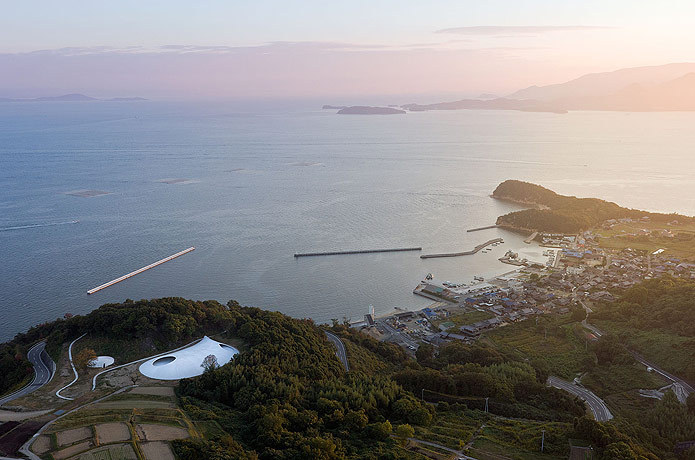
From a Water Drop
Starting the journey from Teshima-karato, visitors walk up a steep mountain road, on the other side of the hill lies the Teshima Art Museum hidden beneath the slope. As visitors walk down the slope, the first gaze will come upon a broad terraced field in front, the blue Seto Inland Sea in the back, and the museum building crouches in between, with its beautiful water-drop-like silhouette freely lying on the ground. The pure white building lying in between the green grassland and the terraces, can only be something not designed by any living creature in this world. It is obvious that the architecture was designed by carefully accounting of the surrounding landscapes. Architect Ryue Nishizawa shaped the main building of the museum with clay, layered the outer part with fixtures and covered with concrete. Through the two windows opened on the top of the building, it resembles the “shape” of the wind, and allows surrounding lights and sounds to peek through and bounce across this organic building. The weather difference through the seasons, such as summer rain or winter snow all becomes part of the exhibition.
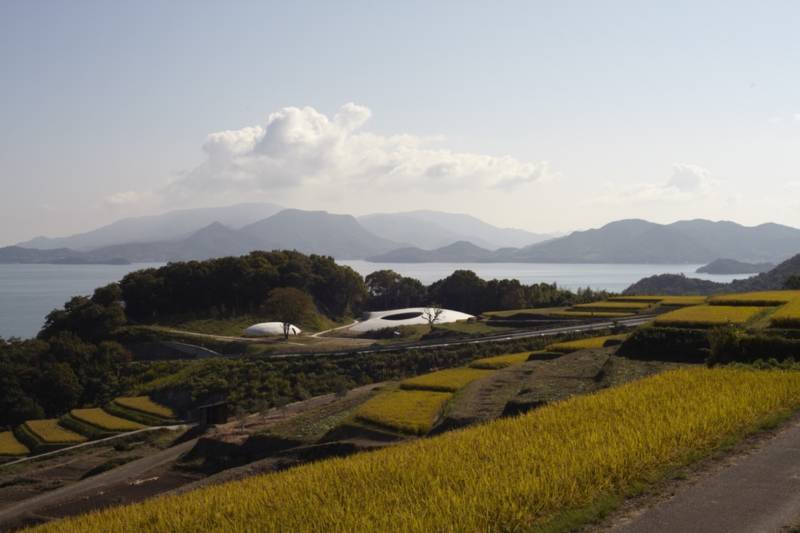
Gazing upon Beauty
In the Teshima Art Museum, the concept of display and exhibit is transformed into another paradigm. Inside the silent and peaceful space, not one piece of general artwork is to be found, the only piece, is the work of Rei Naito, “Bokei.” The piece is characterized by droplet from underground water that seeps up onto the surface through 180 holes on the ground, radiating through the building with the wind or the slopes, leaving traces of water on the floor. Sometimes they follow their own path, sometimes they gather into a pond; while observing how the water appears and disappears, the visitors’ mind is sucked into the cycle of the Bokei. I cannot help but remember about sitting in my father’s car when I was a little kid. Whenever it rains, I would stare on the water drops on the car window. At that time, there were no smartphones yet, the only way to link to the world was through your own imagination and curiosity. Nowadays, people always keep a faster pace, but inside this space that the art museum provides, people can easily sit or lie down, calming themselves inside this incredible atmosphere constructed by liquid material and something even greater, as if the time freezes here into a singularity point. We become what we used to be when we are our younger selves, willing to spend hours just to embrace the pure beauty.
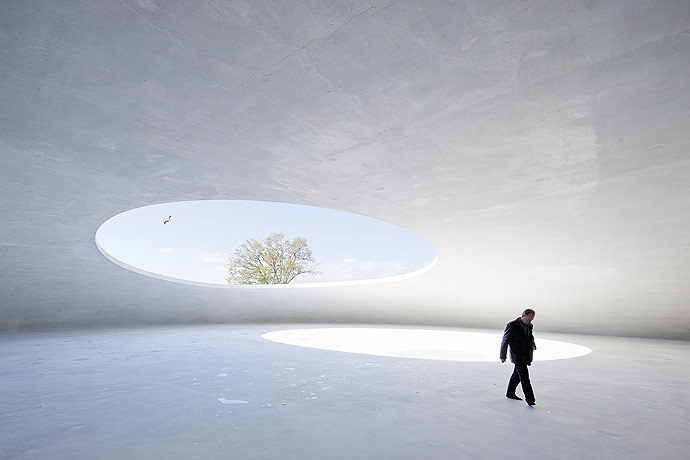
Prosperity Ultimately Falls
Inujima, at the north east of Teshima, is only 0.54 square kilometers. The building of the art museum used to be the Inujima Seirensho, that was built in 1909. It once brought wealth and prosperity to the island, feeding nearly 2,000 workers and producing 300 tons of copper every month. However, as the price of copper dropped greatly along with the end of World War I, the copper smelting industry fell apart like bubble popping, leaving the refinery building that had been operated for only a decade as the only evidence left that the industry has ever existed. The buildings, chimneys and the copper leftovers that the Inujima Seirensho has left on the island were so well preserved that the Ministry of Economy, Trade and Industry in Japan declared it as one of the buildings in the group of historic sites that played an important part in the industrialization process of Japan. The Japanese government sold the island to the Fukutake group, in order to execute the first phase of its Inujima art project. Sumbuchi Hiroshi as the main architect and Yanagi Yukinori as art director of the project, they worked together united under the concept of “heritage, architect, art, environment” to reactivate the historical industrial site and transformed it into a new experience to the world.
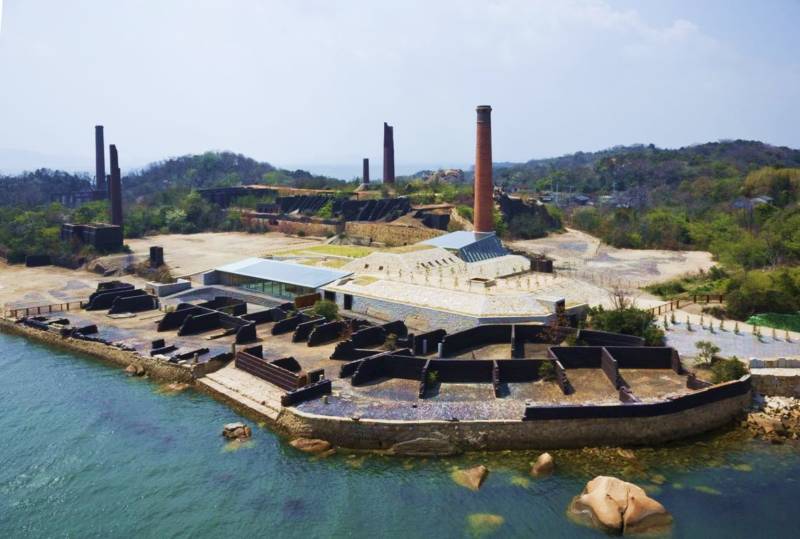
Confessions from Mishima Yukio
“My first—unconscious—encounter was in the summer of the defeat, in the year 1945. A relentless sun blazed down on the lush grass of that summer that lay on the borderline between the war and the postwar period—a borderline, in fact, that was nothing more than a line of barbed wire entanglements, half broken down, half buried in the summer weeds, tilting in all directions. I walked in the sun’s rays but had no clear understanding of the meaning they held for me."
――Mishima Yukio Sun and Steel
The inspiration of the Inujima Seirensho Art Museum comes from the famous book, Sun and Steel, by Mishima Yukio. This book is also well known as one of the greatest masterpiece of Mishima Yukio, as it is a creation that an author could create by pushing themselves to the limit of consciousness, and also as it is the last confession of Yukio. The museum is designed by the artists to reflect the tone of nothingness in the book, allowing the visitors to gaze into the non-stop reflecting self through a long dark aisle covered with mirror, then entering a secret chamber, known as the “Hero Dry Cell”. Yanagi Yukinori took apart the “house of pines and waves” that Mishima Yukio used to live for 13 years in Tokyo and reassembled the building along with the stones from Inujima into structural displays inside this chamber. At the end of the chamber, copper made fonts clearly prints out the words extracted from works by Mishima Yukio – Sun and Steel, The Voices of the Heroic Dead and the last words of Mishima Yukio before he committed suicide. Through the contrast between light and heavy, bright and darkness, the Inujima Seirensho Art Museum tried to imply the unspeakable words through the works of Mishima Yukio, an author who has repeatedly voiced out his denouncement towards the Japanese society. A common answer is that the artist probably wants to allow the visitors to rethink about the pollution from modern industries; however, this issue is not directly addressed in the exhibition, but the way how the museum is designed gives more opportunity for the visitors to observe the historical site, and think about their own answers and solution toward this issue.
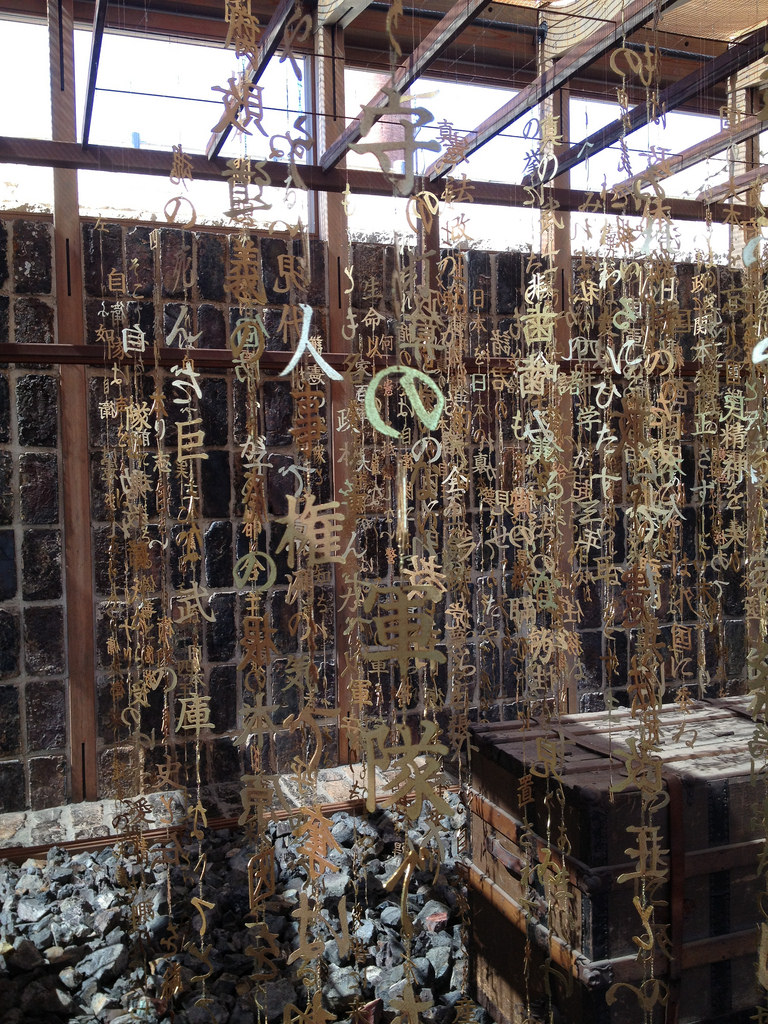
Possibilities of an Island
If we trace back the history of the two islands, there is a similarity between Teshima and Inujima. With the government of Kagawa’s permission in 1975, over 600,000 tons of industrial waste were disposed on Teshima and was not until 2,000 that the islanders received apology and compensation from government. Inujima, as previously mentioned, was once wealthy and prosper due to human activities, but the prosperity also quickly faded away due to fast changes, leaving nothing else but the industrial wastes on the island. The museum projects gave a new life to the islands, attracting numerous visitors to come and visit, allowing the islands a chance of re-birth. The once deserted terrace fields on Teshima, is now re-opened by locals in 2009, and now the museum is surrounded by terrace field growing rice crops. This reminds us that art isn’t just for intervention but can also grow with the community. Nowadays, young people start to move back to their hometown, running shops or hotels during the time of Art Setouchi. The rice, vegetable, and spring water on the island also becomes products to be provided in the museum, allowing the recovery of local agriculture. However, there are still contradictions that have not been mentioned between the daily life of the locals and the tourists’ gaze of the visitors. Between modernization and tradition, these remote islands are usually the place that goes through the most impact, however it also symbolizes infinite chances and opportunities. Here, the museum acts as a convergent point that gathers people to the island to further experience how architecture, art, or memory of the islands strives to incorporate with the infinite scenery in front of them.
References:
- Setouchi Triennale
- Teshima Art Museum
- Inujima Seirensho Art Museum
- Fang, Hui-chieh, 2013, “The Practice of the Spirit of Place in Teshima Art Museum,” Museum Studies 121(33), no. 3 (2014): pp.86-91.

